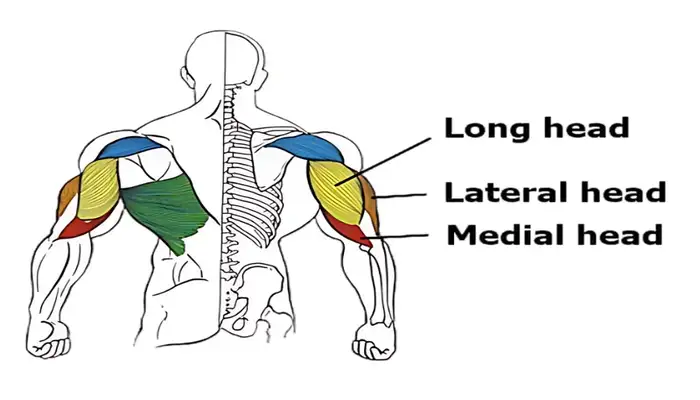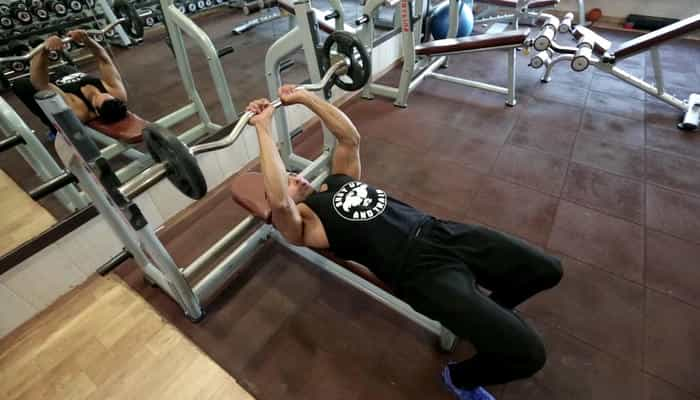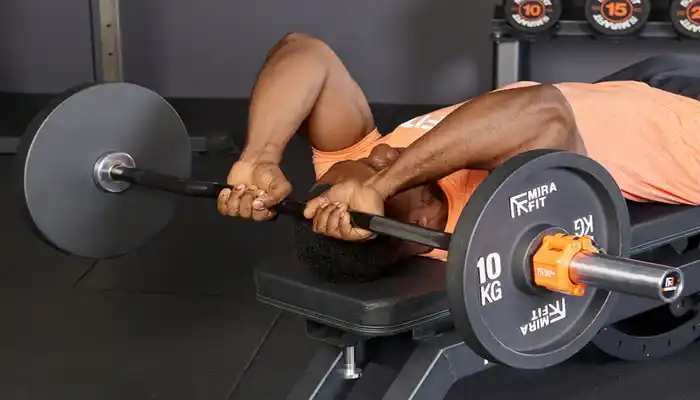Skull crushers are a powerful triceps exercise that can transform your arm training routine. Known for isolating the triceps muscles like no other, this movement is a favorite among fitness enthusiasts.
But do you know which part of the triceps it really targets, or how different equipment changes the results? From dumbbell skull crushers to EZ bar variations, there’s more to this exercise than you might think — let’s explore!

What Are Skull Crushers?
Skull crushers are a popular triceps exercise that focuses on strengthening the upper arms. This exercise involves lying on a bench and lowering a weight, such as a dumbbell or EZ bar, towards your forehead, then extending your arms back up.
The movement primarily targets the long head of the triceps. You can perform skull crushers with dumbbells, barbell skull crushers, or even with a cable machine. Whether you’re doing dumbbell skull crushers or EZ bar variations, this exercise is a great addition to any arm workout routine to build size and strength.
You may also like: Fasted Cardio: What It Is, Benefits, and How It Helps Fat Loss
How Do Skull Crushers Work for Triceps?

Skull crushers are effective for targeting the triceps brachii, the large muscle at the back of the upper arm. The triceps consist of three heads: the long head, lateral head, and medial head.
When performing skull crushers, the exercise primarily activates the long head of the triceps, which is responsible for elbow extension and plays a significant role in arm strength and size.
As you lower the weight towards your forehead and then extend your arms, the long head undergoes maximal stretch and contraction, leading to muscle growth and improved arm definition.
The Best Skull Crushers Variations: EZ Bar, Dumbbell, and More
EZ Bar Skull Crushers

Skull crushers EZ bar variation is one of the most popular forms of this triceps exercise. The curved grip of the EZ bar reduces wrist strain while effectively targeting the triceps muscles worked, especially the long head. This makes it a safer and joint-friendly alternative to barbell skull crushers, while still promoting strength and size.
Advantages
✔ Wrist-friendly grip reduces joint strain
✔ Effectively targets the triceps long head
✔ Allows moderate to heavy loads safely
✔ Perfect for balanced skull crushers triceps workouts
Disadvantages
✖ Limited range of motion compared to dumbbell skull crushers
✖ May still stress elbows with excessive weight
Dumbbell Skull Crushers

Dumbbell skull crushers allow for a greater range of motion and independent movement of each arm. This variation targets the triceps brachii while helping correct muscle imbalances.
Performing skull crushers with dumbbells on a flat or incline bench engages the triceps long head more, especially during the stretch phase, making it a valuable addition to your skull crushers workout.
Advantages
✔ Greater range of motion for deeper triceps stretch
✔ Independent arm movement corrects muscle imbalances
✔ Versatile — can be done flat, incline, or decline
✔ Popular in skull crushers with dumbbells routines
Disadvantages
✖ Requires more control and balance
✖ Heavier dumbbells may be awkward to handle
Barbell Skull Crushers

The classic barbell skull crushers are ideal for lifters aiming to lift heavier and build bigger triceps. This skull crushers exercise effectively isolates the triceps brachii, though it can put pressure on the wrists. Adjusting grip width or switching to an EZ bar can ease discomfort while maintaining muscle activation.
Advantages
✔ Greater range of motion for deeper triceps stretch
✔ Independent arm movement corrects muscle imbalances
✔ Versatile — can be done flat, incline, or decline
✔ Popular in skull crushers with dumbbells routines
Disadvantages
✖ Requires more control and balance
✖ Heavier dumbbells may be awkward to handle
Cable Skull Crushers

Skull crushers cable variation ensures continuous tension on the triceps through the entire movement. Using a rope or bar attachment, this exercise is excellent for isolation, especially at the top contraction point.
The constant load makes it a smart option for hypertrophy and definition-focused lifters seeking effective skull crushers alternatives.
Advantages
✔ Continuous tension throughout the movement
✔ Adjustable resistance and angles
✔ Smooth, controlled motion reduces joint stress
✔ Excellent for hypertrophy and skull crushers alternatives
Disadvantages
✖ Requires access to a cable machine
✖ Typically limited to lighter or moderate loads
Incline Skull Crushers

Incline skull crushers adjust the angle of the arms, placing extra emphasis on the triceps long head. By lying on an incline bench, you stretch the triceps more during the movement, enhancing muscle fiber engagement. This makes it a smart choice for variety in any skull crushers workout.
Advantages
✔ Greater triceps long head activation due to arm position
✔ Adds variety and fresh stimulus to a skull crushers workout
✔ Reduces shoulder strain compared to flat bench versions
Disadvantages
✖ Setup takes more time
✖ Requires careful control to avoid losing balance
✖ Less suitable for very heavy lifts
You may also like: Best Lat Pulldown Variations for a Stronger Back
Understanding Skull Crushers: Which Triceps Head Does It Target?
Skull crushers are one of the best exercises to build big, strong arms. This triceps exercise mainly targets the triceps brachii, which has three parts or “heads” — the long head, lateral head, and medial head.
When you perform skull crushers using a barbell, EZ bar, or dumbbells, the movement mostly focuses on the long head of the triceps. The triceps long head stretches when your arms are overhead, making skull crushers workout perfect for hitting this part. Variations like incline skull crushers, skull crushers with dumbbells, or cable skull crushers can help you target this muscle even better.
If you want strong, full triceps, mix db skull crushers, skull crushers EZ bar, and standing skull crushers into your routine. These movements also act as good skull crushers alternatives, adding variety to your arm training while keeping pressure on the triceps long head.
Why Does Elbow Pain Happen During Skull Crushers?
Skull crushers are a very effective triceps exercise, especially for targeting the triceps long head. However, many lifters experience elbow pain when doing barbell skull crushers, EZ bar skull crushers, or dumbbell skull crushers. Let’s understand why.
When performing skull crushers, your elbows stay bent and under load for the entire movement. This constant tension directly stresses the elbow joint, tendons, and small muscles around the area. As you lower the weight — especially with heavy barbell skull crushers — the elbows are forced into an unnatural angle, increasing joint pressure.
Several factors increase the risk of elbow pain:
- Poor form — letting elbows flare out or moving them too much.
- Lifting too heavy — placing more load than your joints can safely handle.
- Weak supporting muscles — if shoulders, forearms, and wrists aren’t strong enough, the elbows absorb extra stress.
- Limited mobility — tight triceps or stiff elbows restrict smooth movement.
- Overuse — doing skull crushers workout too frequently without enough rest.
Even db skull crushers and skull crushers with dumbbells, though safer, can cause discomfort if form and control are poor.
How to Avoid Elbow Pain in Skull Crushers
You don’t have to stop doing skull crushers — you just need smarter, safer habits. Here’s how:
Choose Joint-Friendly Variations
Switching to skull crushers EZ bar reduces wrist and elbow stress because of its angled grip. Dumbbell skull crushers and skull crushers cable offer a natural, flexible range of motion, reducing pressure on the joints.
Warm-Up Properly
Before heavy sets, perform light triceps exercises like cable skull crushers or rope pushdowns. This increases blood flow, warms the elbow joint, and prepares the triceps for heavier loads.
Focus on Form, Not Heavy Weight
Lower the weights slowly in a controlled motion. Don’t let the elbows flare out or lock at the top. Avoid chasing numbers in barbell skull crushers — muscle growth comes from tension and control, not from maxing out.
Use Incline Skull Crushers
Incline skull crushers shift the angle of your arms, creating a better stretch on the triceps long head while reducing elbow tension. This makes them a smart alternative to flat barbell skull crushers.
Strengthen Supporting Muscles
Include forearm, shoulder, and core exercises in your program. Stronger supporting muscles take pressure off the elbows, especially during skull crushers workout sessions.
Limit Frequency
Doing skull crushers triceps exercises too often can lead to overuse. Keep them 1-2 times a week, giving your elbows proper rest.
When to Choose Alternatives
If pain persists, replace barbell skull crushers with skull crushers with dumbbells, cable skull crushers, or standing skull crushers. These are excellent skull crushers alternatives that reduce joint pressure while still working the triceps brachii.
Db skull crushers and EZ bar skull crushers are especially helpful for keeping a natural elbow path, while skull crushers cable offer constant tension without heavy strain.
You may also like: The Ultimate Guide to Bench Press: Techniques, Variations, and Benefits
Common Mistakes to Avoid When Doing Skull Crushers
Skull crushers are one of the most effective triceps exercises, especially for targeting the triceps long head. However, many people unknowingly make mistakes that reduce the effectiveness of the exercise and increase the risk of injury — especially to the elbows. Let’s look at the most common mistakes and how to fix them.
Using Excessive Weight
One of the biggest mistakes is using too much weight on barbell skull crushers or skull crushers EZ bar. Heavy loads force your elbows and joints to absorb more stress than your triceps can safely handle. This increases the risk of elbow pain and reduces control, making the movement less effective.
Fix: Focus on moderate, controlled weights during db skull crushers and dumbbell skull crushers. It’s not about lifting heavy — it’s about tension and control.
Flaring the Elbows
Letting your elbows flare out during skull crushers workout puts unnecessary stress on your shoulders and reduces tension on the triceps long head. This also increases the chances of elbow discomfort.
Fix: Keep your elbows slightly tucked in during skull crushers with dumbbells and skull crushers EZ bar. The movement should come from your forearms only.
Poor Range of Motion
Many lifters perform skull crushers with a limited range, lowering the weight halfway. This reduces muscle activation, especially in the triceps long head, and makes the exercise less effective.
Fix: During dumbbell skull crushers, lower the weight slowly to just above your forehead or even slightly behind your head for a deep stretch. Incline skull crushers and cable skull crushers naturally promote a better stretch.
Locking Out the Elbows
Locking your elbows at the top of a skull crushers exercise transfers tension from the triceps to the joints, increasing injury risk.
Fix: Stop just before full lockout at the top of your skull crushers triceps movement. Keep continuous tension throughout the set.
Incorrect Grip Selection
Using a straight bar for barbell skull crushers can strain the wrists and elbows because it forces your hands into an unnatural position.
Fix: Choose a skull crushers EZ bar, db skull crushers, or skull crushers with dumbbells for a more comfortable, joint-friendly grip. Cable skull crushers are also a great, smooth alternative.
Skipping Warm-Ups
Jumping straight into heavy skull crushers workout without preparing your elbows and triceps increases the risk of injury.
Fix: Warm up with light triceps exercises like rope pushdowns or cable skull crushers before moving to heavy sets.
Ignoring Variation
Repeating the same barbell skull crushers every session can lead to overuse injuries, particularly in the elbows.
Fix: Mix in standing skull crushers, incline skull crushers, skull crushers cable, or dumbbell skull crushers. These skull crushers alternatives help prevent joint stress and target the triceps long head from different angles.
You may also like: The Ultimate Guide to Deadlifts: Benefits, Variations, and Proper Form
FAQs (Frequently Asked Questions)
To perform skull crushers, lie on a bench holding a barbell, EZ bar, or dumbbells. Lower the weight towards your forehead by bending your elbows, then extend your arms. This skull crushers exercise primarily targets the triceps. Variations include standing skull crushers and incline skull crushers for different angles.
Skull crushers work the triceps, focusing mainly on the long head. This skull crushers exercise involves elbow extension, activating all skull crushers muscles worked. Popular tools include barbell skull crushers, dumbbell skull crushers, and skull crushers cable. Alternatives like dips and pushdowns complement skull crushers triceps training effectively.
For skull crushers with dumbbells, lie flat holding two dumbbells. Lower them towards your head by bending your elbows. Extend your arms back up, fully contracting the triceps. This dumbbell skull crushers or db skull crushers variation increases range of motion, targeting the skull crushers triceps effectively.
Skull crushers are a popular triceps exercise where a weight is lowered towards the forehead by bending the elbows, then raised by extending the arms. It’s highly effective for skull crushers triceps growth. Options include skull crushers ez bar, skull crushers dumbbell, skull crushers cable, and incline skull crushers.
Skull crushers muscles worked primarily involve the triceps, especially the long head. It’s a key skull crushers workout for building arm strength and size. Variations like standing skull crushers or incline skull crushers change the muscle emphasis slightly, making it versatile among skull crushers alternatives.
Skull crushers work the triceps muscles, with a focus on the long head. As a core skull crushers triceps movement, it improves upper arm strength. Equipment options include skull crushers barbell, skull crushers dumbbell, or skull crushers cable, with incline skull crushers enhancing range of motion.
To do skull crushers with dumbbell, lie on a bench holding a dumbbell with both hands. Lower it behind your head, then extend your arms. This variation of skull crushers exercise enhances triceps isolation. It’s a powerful skull crushers dumbbell alternative to skull crushers barbell or EZ bar versions.
Skull crushers target which head? They primarily engage the long head of the triceps. By adjusting to incline skull crushers or skull crushers cable, you can shift emphasis within the triceps. Popular tools include skull crushers ez bar, db skull crushers, and standing skull crushers.
Skull crushers work the triceps brachii, especially the long head. This skull crushers triceps movement enhances arm strength and size. Variations like barbell skull crushers, skull crushers with dumbbells, and skull crushers ez bar provide different angles for optimal skull crushers workout benefits.
Skull crushers target the triceps, with a focus on the long head. They’re a vital skull crushers workout for upper arm strength. Effective tools include barbell skull crushers, db skull crushers, skull crushers cable, and incline skull crushers for varied muscle activation. Consider skull crushers alternatives too.
Skull crushers work the triceps brachii muscle, mainly the long head. This skull crushers triceps exercise is popular for building arm mass and definition. Variations such as standing skull crushers, skull crushers dumbbell, and incline skull crushers offer diverse angles and skull crushers muscles worked intensity.
Skull crushers are a push exercise since they involve elbow extension, primarily activating the triceps. Part of a push day workout, skull crushers triceps routines can use skull crushers barbell, skull crushers dumbbell, skull crushers cable, or incline skull crushers to add variety and target different muscle heads.
To perform skull crushers with a curl bar (EZ bar), lie flat, holding the bar above your chest. Bend your elbows to lower the bar towards your forehead, then extend. This skull crushers ez bar variation reduces wrist strain while effectively targeting the skull crushers triceps.
Skull crushers target which head of the triceps? Mostly the long head. Modifying with incline skull crushers or skull crushers cable can shift emphasis slightly. Equipment choices like skull crushers ez bar, skull crushers dumbbell, or db skull crushers enhance workout diversity and skull crushers muscles worked.
Yes, skull crushers are excellent for triceps development. They effectively isolate the triceps muscles, particularly the long head. Popular options include skull crushers barbell, skull crushers dumbbell, skull crushers cable, and standing skull crushers. For variety, try skull crushers alternatives like pushdowns and dips in your routine.
To do dumbbell skull crushers, lie on a bench with a dumbbell in each hand. Lower the weights towards your head by bending the elbows, then extend. This db skull crushers movement isolates the skull crushers triceps, offering better range than barbell skull crushers or skull crushers ez bar.
Skull crushers target which head? Primarily the long head of the triceps. Variants like incline skull crushers, skull crushers cable, and standing skull crushers adjust angles for better engagement. Using skull crushers dumbbell, skull crushers ez bar, or db skull crushers provides diverse skull crushers muscles worked activation.
Skull crushers workout the triceps muscles, especially the long head. They’re a staple in arm training, performed with barbell skull crushers, db skull crushers, skull crushers cable, or skull crushers ez bar. Combine with skull crushers alternatives for a balanced skull crushers triceps training plan.
Skull crushers are good for isolating the triceps, enhancing upper arm strength, and increasing muscle size. They target the long head primarily. Options include skull crushers dumbbell, barbell skull crushers, skull crushers cable, and standing skull crushers. Add skull crushers alternatives to balance your skull crushers workout.

